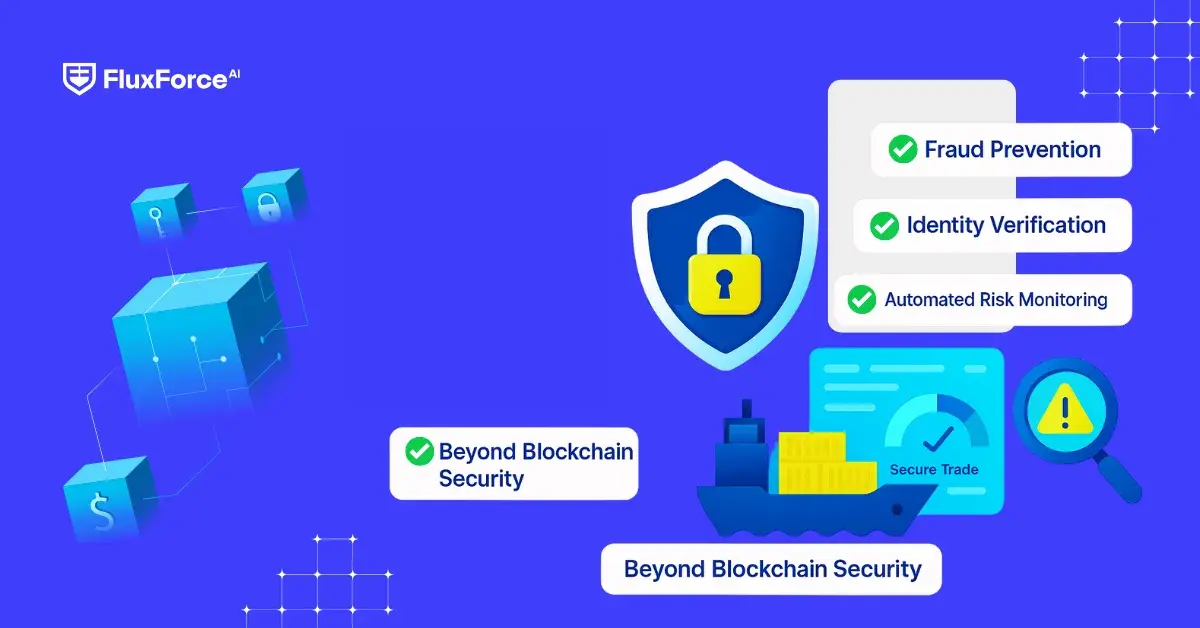Listen to our podcast 🎧

Introduction
Trade finance has always supported international business by helping companies manage payments, reduce delays, and handle risks when goods and services move across borders. At the same time, it has often been exposed to fraud, cybercrime, and compliance gaps. With trillions of dollars moving every year, trade finance remains a major target for attacks.
Many in the industry turned to blockchain finance as a possible solution. Its ability to create trusted and tamper-resistant digital records looked promising. Over the past decade, banks and global companies have tested blockchain in trade finance to improve transparency and reduce paperwork. The benefits are easy to see: faster settlements, fewer manual errors, and better tracking of trade documents. This is why terms like blockchain for trade finance, finance blockchain, and distributed ledger technology are now part of regular conversations in digital finance.
The problem is that fraudsters have not disappeared. Issues like trade finance risk, credit risk in international trade, and financial security are still present. Even with the clear benefits of blockchain in finance, there are weak points in compliance checks, cross-border rules, and identity verification.
This shows that blockchain technology in finance is powerful but cannot be the only layer of protection. To deal with trade finance security challenges the industry needs more than blockchain. Stronger solutions that combine blockchain with smart fraud detection, real-time monitoring, and automated compliance are required. Only then can businesses handle risks of international trade with greater confidence.
Blockchain’s Strengths in Trade Finance

Transparency Across All Parties
A key strength of blockchain trade finance is transparency. Every participant in a deal can see the same shared record, which lowers disputes and builds trust. With blockchain in finance, transactions are verified in near real time, making it harder for false data or duplicate records to pass through. This is valuable in cross-border trade where paperwork often gets repeated or misplaced.
Digital Processes Instead of Paperwork
Traditional trade finance depends heavily on invoices, letters of credit, and customs forms. Each step takes time and is prone to mistakes. By shifting these records to blockchain technology finance, businesses reduce manual work. Smart contracts can trigger payments once agreed conditions are met. This saves time and helps goods move smoothly across borders.
Stronger Protection Against Fraud
Fraud is a constant risk in trade finance. Fake documents, hidden liabilities, and false identities can create large losses. With blockchain in finance banks and companies share one verified record that is difficult to alter.
Reliable Audit and Compliance Records
Blockchain also strengthens audit trails. Every action is recorded permanently, which helps regulators and compliance teams track trades with confidence. This reduces the cost of audits and supports global standards. Institutions testing blockchain finance industry are already seeing improvements in compliance and secure data sharing.
Blockchain limitations in trade finance

Gaps in Legal and Regulatory Frameworks
While blockchain and trade finance has shown promise, laws across different countries are still not aligned. Each region has its own trade rules and compliance checks which means a blockchain record accepted in one country may not be valid in another. Without consistent rules, the benefits of blockchain for finance are limited.
Limited Integration With Existing Systems
Most banks and corporations already rely on large, complex financial systems. Connecting blockchain technology in finance with these legacy systems is expensive and time-consuming. Without smooth integration, businesses end up running blockchain pilots without moving to full adoption. This slows progress in securing trade finance blockchain solutions.
Privacy and Data Confidentiality Issues
Transparency is useful, but in trade finance some information must remain private. For example, pricing agreements or credit details between two parties may not be meant for everyone on the network. With blockchain security, once data is on the ledger, it cannot be fully hidden or removed. This creates concerns about confidentiality, especially when sensitive data is exposed.
Scalability Concerns in High-Volume Trades
Global trade involves millions of transactions every day. Current blockchain financing platforms struggle to process such high volumes at the required speed. Slow performance limits their ability to manage large-scale adoption in supply chain finance and other areas of international trade.
Remaining Risks Beyond the Ledger
Even with blockchain, threats like trade finance risk, international financial risks of trade payments, and commercial risk in international trade continue. Cybercriminals can still target user accounts, fake identities, or bypass security checks outside the ledger. This shows that blockchain addresses part of the challenge, but not all of it. Stronger systems for financial fraud prevention and compliance in finance are still required.

Shaping the Future of AI in Finance
Fluxforce research uncovers how banks and enterprises are adapting to fraud, compliance, and data challenges in 2025.
Risks That Go Beyond Blockchain
Human and Process-Driven Weaknesses
Even the most advanced technology cannot fully protect against errors made by people. In trade finance, incorrect documentation, weak due diligence, or overlooked red flags can open doors for fraud. Blockchain records the data, but it cannot guarantee that the data entered was correct in the first place. This human layer of risk remains a serious challenge.
Cyber Threats at Access Points
Most breaches do not happen on the blockchain itself but at the points where users connect to it. Hackers target login credentials, devices, and unsecured APIs to bypass trusted systems. In global trade, this makes cyber threats in trade finance as damaging as document fraud. A strong security posture must extend beyond the ledger to protect every access point.
Financial and Credit Exposure
Banks and corporates face financial exposure that no ledger can prevent. Buyers may default on payments, suppliers may fail to deliver, or economic conditions may shift overnight. These realities form part of trade finance risk, and while blockchain helps with traceability, it does not eliminate credit risk or commercial disputes.
Compliance Pressures Across Jurisdictions
Global trade spans multiple countries, each with unique compliance rules. Anti-money laundering (AML), know-your-customer (KYC), and sanctions screening are areas where blockchain alone falls short. Even with blockchain in finance, compliance still requires advanced monitoring tools, regulatory reporting, and coordination with legal frameworks. Technology cannot replace this regulatory diligence.
The Broader Supply Chain Factor
Trade finance is tightly linked with supply chain operations. A delayed shipment, political instability, or natural disaster can disrupt contracts regardless of how secure the ledger is. Supply chain finance depends not only on records but on real-world movement of goods and capital. Blockchain cannot protect against physical and geopolitical risks that continue to threaten international trade.
Building a Layered Security Approach in Trade Finance

Blockchain is a strong foundation, but security in trade finance requires multiple layers working together. A single technology cannot manage risks that involve fraud, compliance, cyberattacks, and geopolitical uncertainty. Institutions are now moving toward combined approaches that bring technology, process, and oversight into one framework.
Combining Blockchain With Advanced Analytics
While blockchain secures the record, advanced analytics identify suspicious behavior. By monitoring transaction patterns, banks can detect early warning signs of financial fraud prevention and address them before they spread.
Practical use cases include:
- Identifying duplicate trade submissions through anomaly detection
- Spotting irregular payment flows across different jurisdictions
- Using predictive models to assess buyer default risk
Strengthening Compliance With Smart Tools
Compliance goes beyond data storage. To meet regulatory expectations, businesses are adding monitoring platforms that work with blockchain to handle compliance in finance.
These tools support:
- Real-time sanctions screening
- Automated KYC validation
- Transparent audit trails for regulators
Securing Endpoints and User Access
Since many breaches happen outside the ledger, endpoint security is as important as the ledger itself. Strong identity and access management systems protect against fraud that targets users rather than technology.
Protective measures include:
- Multi-factor authentication for all trade participants
- Encryption for data transfers and document storage
- Continuous monitoring of login behavior and unusual activity
Integrating Supply Chain Risk Management
.webp?width=1200&height=800&name=Building%20a%20Layered%20Security%20Approach%20in%20Trade%20Finance%20(2).webp)
Trade finance security challenges cannot be solved without considering the wider supply chain. Institutions are now integrating blockchain with supply chain risk management solutions to monitor both financial flows and the physical movement of goods.
Risk management strategies include:
- Tracking shipment delays and linking them with trade contracts
- Using IoT sensors to provide trusted delivery updates
- Creating shared dashboards for banks, suppliers, and buyers
The Value of a Layered Framework
The lesson for banks and corporates is clear: blockchain offers strength, but only as part of a wider security structure. A layered framework that blends blockchain, analytics, compliance, and endpoint protection reduces exposure to both traditional fraud and modern cyber threats.
Strengthen Trust in Global Trade

Building Safer Trade Finance for the Future
Blockchain has brought transparency and trust to trade finance, but true security depends on more than one tool. Banks, exporters, and regulators need a mix of technology and governance to protect global transactions.
Where Blockchain Needs Support
- AI and analytics help detect fraud patterns and risks that blockchain alone cannot reveal.
- Cybersecurity controls are needed to protect digital trade systems from hackers.
- Clear governance ensures people inside the system follow rules and avoid misuse.
What Comes Next
- Trade platforms will combine blockchain with AI and secure cloud systems.
- Regulators and banks will work together on common rules for safer digital trade.
- Risk management will remain a top priority for cross-border finance.
Conclusion
Blockchain has proven its value in finance by reducing fraud and improving trust. But depending only on it leaves gaps. The strongest approach is a layered security model that combines blockchain with AI, compliance, and active risk management.
This mix gives global trade the protection it needs while keeping trust and efficiency at the center.
Frequently Asked Questions
- Fake identities during KYC
- Buyers defaulting on payments
- Trade document forgery before uploading
- Cyberattacks targeting login credentials
- Collusion between trusted parties
- Blockchain ensures data integrity but not data accuracy.
- Real-time sanctions screening
- Automated suspicious activity reporting
- Dynamic AML/KYC checks
- Trade document forgery before uploading
- Local trade rules and cross-border documentation requirements
- Blockchain gives records but does not handle dynamic compliance obligations.
- Expensive integration with legacy systems
- Lack of global legal recognition
- Concerns about scalability for high transaction volumes
- Resistance from institutions comfortable with existing processes
- User login credentials
- Mobile devices
- Weak APIs connecting blockchain to legacy systems
- Insider misuse
- The ledger itself is secure, but the entry and exit points are vulnerable
- Spotting duplicate trade submissions
- Identifying suspicious payment timing
- Predicting default risks from past patterns






Share this article